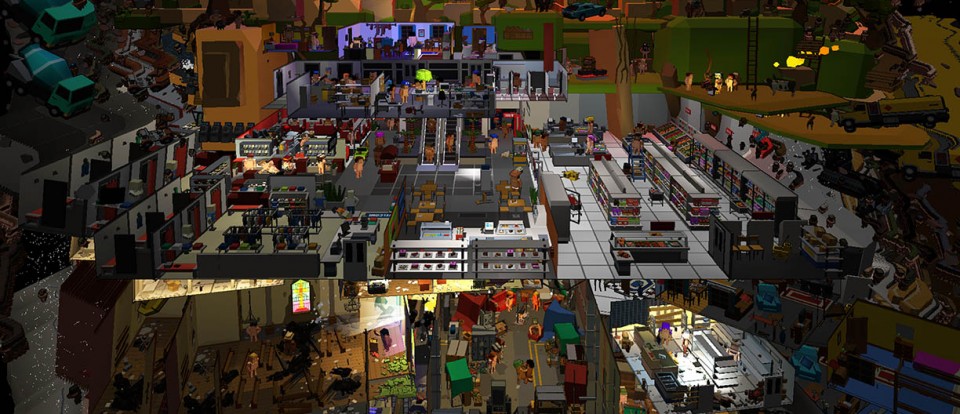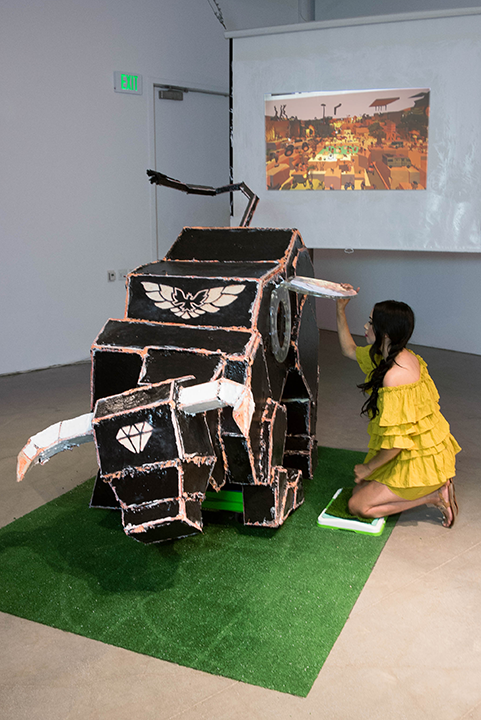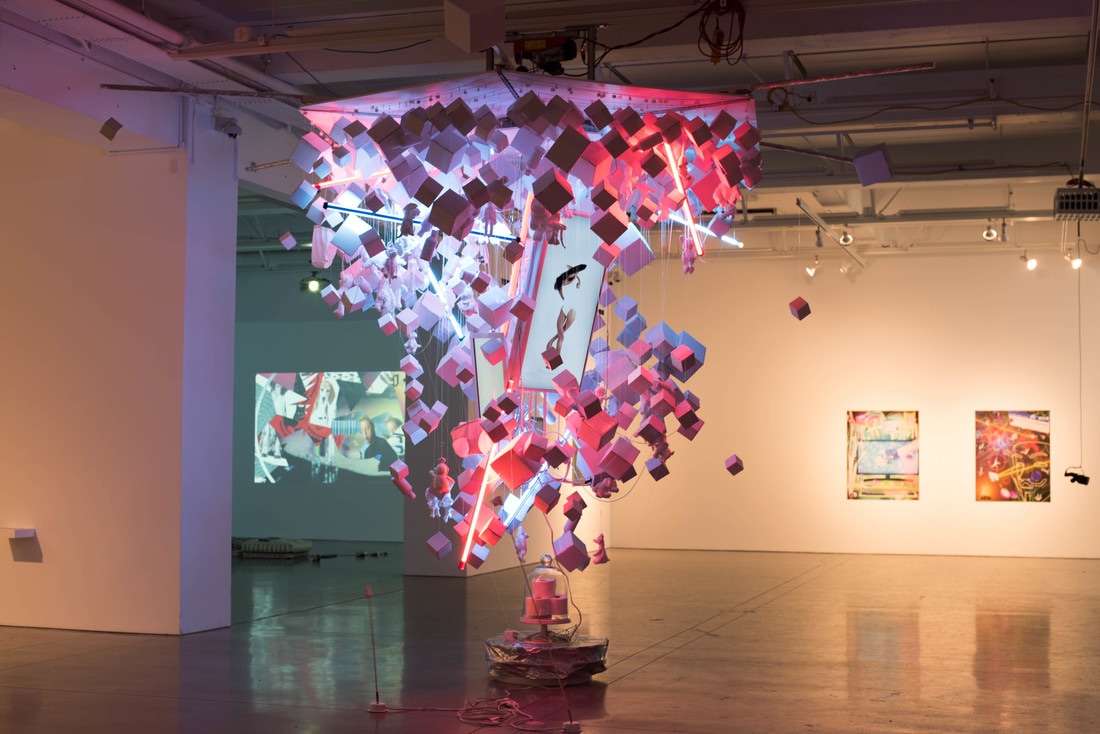
Interview with Lander
Posted on July 5th, 2017
by
Lee Tusman
Over the past few weeks we’ve been interviewing UCLA’s Design | Media Arts Department grads about their thesis work in the exhibition Delete Me at The New Wight Gallery. Many of these works are not explicitly games but use game engines, feature game art or installation, or in other ways are engaging with the vocabulary or tools of games in the creation of new media artworks.
What is your own relationship to gamer culture? Are there aspects of game culture you are referencing or appropriating within your work?
I’m interested in gamer culture because I have always enjoyed games. The fact that games have now eclipsed the movie industry in revenue makes exploring the effect of games on broader culture an obviously worthwhile pursuit. I’m not a hardcore gamer by any means, but I try to play something new once a month and I read a lot about games and game design. The process of making games and the systems thinking that game creating and game playing employ are fascinating to me. I find that making art with and about and through these tools is incredibly engaging.
I poke fun at the unhealthy junk food consumption of gamers but it’s also self-deprecating. Mt. Dew has been a staple of my diet since I was a kid growing up in Nebraska.
In RUMEN8 THE END, I adopted a blocky voxel art style, ubiquitous in the past several years because of Minecraft. It is very “now.” Appropriating the style is not meant as a sign of high regard but rather to create content that both speaks in a specifically game oriented language and which is easily accessible to a broad audience. It is a lowest common denominator sort of thing. The simulated world I created inside the bull was inspired by Hieronymus Bosch’s quirky not quite realistic humans. I wanted to find a contemporary equivalent that also read immediately as “virtual.” It also seems like Minecraft elicits an idea of creative labor in its style of gaming. A player is expected to generate content and become part of the system in ways that parallel the demands of late capitalism, the “subject” of RUMEN8. Implicating the viewer of the work in the ideology was my intention.
How would you describe your medium?
My primary medium has been installation in the last couple of years, but previously I explored painting, drawing, game design and many other more focused mediums. The great thing about installation art is that it is so resistant to the formalist concerns that seem to dominate discussions of more focused mediums. Now I have a tremendous appreciation for what formalism has made apparent to us. This drilling down into what makes each type of media unique is great. I attempt to bring my awareness of those unique qualities to bear when I include different types of media in my installation work. For example, I was very interested in exploring and exposing the expressive qualities of plywood, crack filler foam and layers of paint in RUMEN8 THE END. I resisted the idea of using these materials to simulate welded metal surfaces although that possibility was quite apparent as I was working. It was important to reveal the material qualities rather than to create an illusion. The primary goal of RUMEN8 THE END was to expose the underlying reality of an ideological illusion. I think it would have muddied the waters to trick the audience regarding my materials. Formalism suited me in this circumstance so I used it as a tool. I think of “Installation Art” as the medium that allows me to use every other media type most freely. Still I’m always trying to claw my way to a new meta position from which to consider the formal qualities of the sub mediums and of my primary medium, installation art, and to push the limits of installation’s expressive potential.
In your work Rumen8 THE END, the viewer must kneel and place their head through a toilet seat (embedded with coins) in the side of an Apis bull, symbolic of wall street. Eye trackers detect your eye movement and guide the movement on-screen of a symbolic story, that is then projected out the back of the bull onto a screen, to the amusement of onlookers. You reference Hieronymus Bosch in your description of the work. Can you talk about some of the ways Rumen8 references or creates a contemporary macabre hellscape?
There is a complex apparatus at work in RUMEN8 THE END in which the viewer must submit and play the fool to interact with the system and allow others to view that interaction on the projection screen. It is mostly playful and humorous but there is an element of abusiveness as well. Bosch’s influence can be seen in many aspects of RUMEN8 THE END. His humor is apparent all throughout the Garden of Earthly Delights painting which was a direct inspiration for me. He depicts hundreds of naked little people engaged in all sorts of bizarre behaviors with each other and their environment. He has a streak of scatological humor that shows itself again and again. A famous example is the musical score tattooed on the buttocks of a character which is being read by a chorus of singers. Another character stares into the mirrored ass of a demon to see herself. Other unfortunates have plants and flutes projecting from their asses. Yet, his painting was a very serious work of contemplative religious art. I tried to capture a similar paradoxical vibe in RUMEN8 THE END.
There are numerous scatological jokes as well as an eschatological theme that springs from ideas of the end of history and the end of art. I wouldn’t call the virtual world of my work a “hellscape.” It is rather a funhouse mirror depiction of the world in which we live now and the ideology we are more and more referring to as “Late Capitalism.” There is a clear hierarchy visible in this world with apocalyptic, violence and poverty ridden spaces at the bottom and a clean white museum space at the top. There are residential, park, commercial, industrial and other types of spaces in between. The idea is that this symbol of capitalism, the bull, is inhabited by this troubling simulation of what the ideology really creates. It is a “hellscape” for many of the inhabitants but certainly not for all.
In this work, you have mentioned economist Francis Fukuyama, often considered one of the ‘fathers’ of modern neoconservatism. What interests you in Fukuyama’s writing? What are ways that your work examines Fukuyama’s writing and outlook?
Fukuyama is most famous for his book, The End of History and the Last Man. To generalize, it stated that liberal capitalism would necessarily be the final ideology for the globalized world, that it would best meet the needs of humankind. What intrigues me about Fukuyama’s 1990’s political philosophy was the idea that history had reached its zenith, that no new major shifts in ideology would ever occur. RUMEN8 THE END, is a response to this idea of “the end of history” but it also considers the apocalyptic sense of the phrase. It depicts the bull as kneeling rather than charging as its Wall Street counterpart does. The Rumen8 bull seems to be in the Tercio de Muerte of a bullfight, bleeding and awaiting a final blow before expiring. The bull looks weathered and beleaguered and shows signs of past eras, tattoos of late seventies muscle car decals and ragged pin-striping, an eagle and diamond link it to the ancient Egyptian Apis bull cult. It can be argued that bits of the Apis mythology remain with us even today. The brush with which its many coats of paint have been applied hangs ruined and limp from the end of the bull’s own tail. This capitalist idol is overburdened by excess, yet it lingers on. Sadly, we lack the clearly imagined future, a new ideology, for which the killing blow might justifiably be struck.
Slowly rotating white rods, and plain 3d-game-like cubes appear as leitmotifs within Knicker Twister. Mountain Dew cans, dipped toys and neon-colored energy drink fluids reappear in your works. How do these icons work within your larger body of work?
I am not attempting to create a strict and static symbolic language with these objects but to allow them to evolve in relation to each other and to the themes I am exploring. Each object resonates in multivalent ways in the various pieces of my art. Many of the objects speak of early childhood to my mind, which, if one believes the psychological experts, determines so very much about each of us. The objects have something to do with indoctrination for me. The simple geometries also reference 3D computer modeling and the virtual worlds that are more and more an influence on the youth. The pumps pushing liquids in endless loops feel like habits and reference biology. The neon colors, caffeinated and sugary contents suggest something unnatural and unhealthy.
These few objects have become signature materials for me in the past two years and their recurrence and evolutions reveal my interest in continually re-examining the possibilities of mundane things, basically trash, to express moods, ideas and complex relationships with each other and the viewer that exist outside the control of written and verbal language.
What is your relationship as artist to your audience? Is there a goal in antagonizing or wielding power over your audience in this installation work?
I’m not interested in wielding power. I definitely do antagonize and frustrate my audience just like good puzzles and games frustrate their players because that builds tension that transforms into a sense of satisfaction and catharsis when the obstacles are eventually overcome. Being a game designer has very much informed my art practice.
One of my favorite art related research projects studied peoples’ responses to abstract color field paintings. The researches produced this great diagram that showed how the viewer when frustrated is faced again and again with the choice of reinforcing their own ego and deciding the art is “bad” or submitting to the artwork. If an artwork is engaging enough a viewer will continue to submit to the aesthetic or affective experience, to tolerate the frustrating aspects of the art and eventually find a new relationship to it which provides them with an expanded sense of art in general and a new mastery of their own perceptions.
In RUMEN8 THE END, I ask the viewer to physically place themselves in a submissive position, just as the Bull is kneeling in submission. I want them to identify with the bull, or to be identified with it by other viewers if they are not so self-aware. The participant is invited to stick his or her face in a toilet seat. Kneeling on a pet pee pad is uncomfortable and the toilet seat is awkward and heavy on top of the viewer’s head. It is very intentionally designed to make the viewer feel the cost of engagement but the reward of the virtual world and the playfulness and humor involved temper that greatly.
Knicker Twister is far less demanding but it’s symbolic opacity presents a different sort of frustration. The scale, movement and chaos of the work is meant to generate a feeling of overwhelm in the viewer that might be considered antagonistic. However, I think the overall pleasant aesthetic allows a viewer to process the experience intuitively and with an embodied cognition that is rewarding.
Photos from Lander and Lander’s website.



